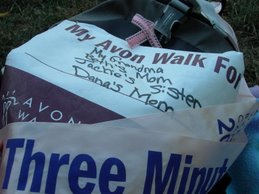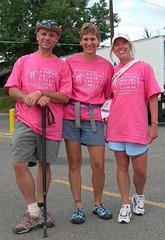Dear Friends of the American Cancer Society:
We are writing to bring you great news. Recently, the American Cancer Society announced that cancer deaths declined in the United States for the second year in a row – a milestone event that indicates dramatic progress is being made against the disease. There were 3,014 fewer cancer deaths in 2004 than in 2003, a significantly larger decrease than the 369 fewer deaths reported the previous year. Thirteen years of continuing drops in the overall cancer death rate have now overtaken trends in aging and growth of the US population, resulting in decreased numbers of deaths.
The decline is strong evidence that decades of groundbreaking research, effective public health policies and public education has been worthwhile. Our hard work toward preventing cancer, catching it early, and making treatment more effective is paying dramatic, lifesaving dividends.
But while these new statistics give us cause to celebrate, it also gives us reason to redouble our efforts. Cancer remains the leading cause of death in Americans under age 85. The adoption of tobacco control policies across the country has contributed to our remarkable progress against cancer, but these gains are threatened by cutbacks in funding for research and prevention programs. A few years after our nation doubled its investment in medical research, Congress cut cancer funding for the first time in more than a decade. While the American Cancer Society will continue its aggressive fight against the disease, our sister advocacy organization, the American Cancer Society Cancer Action NetworkSM(ACS CAN), will work to inspire our lawmakers to recommit themselves to it as well.
We wanted you, as a friend of the American Cancer Society, to be aware that your support has helped us make remarkable progress against cancer. To learn more about the American Cancer Society call us at 1-800-ACS-2345 or visit www.cancer.org.
Wednesday, January 31, 2007
Tuesday, January 09, 2007
Finding a Good Gym

Below are three things to consider when looking for a gym in which to join. These are from Prevention Magazine Online.
If you haven't looked for a gym before, going to visit gyms and doing a "free" workout before signing up for something is part of the regular process. I have toured many gyms - and after doing one workout at a place you know if it is the right gym for you.
Start with location
Look for gyms near your home, workplace, or favorite shopping center. Even a 15-minute drive out of your way can reduce the chances that you'll use the club as often as you should.
Determine your must-haves Because your goal is weight loss, comprehensive weight-management programs or nutritional counseling should be at the top of your list. Then consider the types of activity you like--classes, solo cardio machines, yoga, Pilates, racquet sports, water exercise, or martial arts. You'll work out more if you enjoy what you're doing. And the more you exercise, the more weight you can lose.
Shop around
You wouldn't buy the first house you see. Ask for free passes to visit clubs at times you plan to use them. A too-long wait for the treadmills could become an excuse to skip a workout.
Meet your (workout) neighbors
When you visit gyms, pay special attention to the members and employees. In one small study of 20 women, those who felt inspired by the club's atmosphere or clientele were more likely to show up to exercise than women who were initially motivated to join a club by other factors (such as a membership deal). The personal relationships and support you get--not the high-end equipment, hottest class, towel service, or saunas--will keep you coming back.
Saturday, January 06, 2007
Walking in the Rain and the Snow

Here are some great cold weather walking tips from the Avon Walk.
1. Dress in layers. The layer next to your skin should be made from a breathable fabric, such as polypropylene, which wicks away moisture from perspiration. Shop for technical fabrics. From jackets to leggings to socks, these clothes pay off in making winter exercise more comfortable. Polypropylene in socks, shirts, and tights provide breathability and wick moisture, while Gore-Tex (rain resistant) and polar fleece in outerwear help retain heat.
2. Avoid overdressing; you'll warm up with exercise. A good rule of thumb is to dress as though it were 20 degrees warmer outside than it really is.
3. Run or walk in a direction which allows the wind to hit your back on your way home. This will help you avoid getting chilled from wind hitting you after you have perspired.
4. Try warming up indoors before going out if possible
5. Keep your walking enjoyable and safe by doing it in daylight and with a friend or group if possible
6. Cover your head and hands. The majority of the body’s heat is lost through extremities.
7. Hydrate! You still need water in cold weather!
8. Change out of your walking clothes as soon as you get inside.
Shoe Tips

Are you thinking about joining Sole Sisters and walking in June? Here are some great shoe tips from the Avon Walk.
• Shop for shoes in the late afternoon. Feet tend to swell during the day.
• Either a walking shoe or a running shoe may be worn for this event. Make sure that you try one of each to see what feels better for your foot type.
• Leave space (1/2 to 3/4 inch) between the tip of your longest toe, and the end of the shoe while standing .
• Athletic shoes should be comfortable from the start, requiring minimal break in.
• When you try on shoes, try on both feet. If one foot is larger than the other, fit the larger foot.
• Make sure the heel fit is snug, and does not slip up and down when you walk.
• Make sure you have ample room in the forefoot for your toes to spread.
• Always consider the four most important benefits when choosing the shoe for you: Fit, Comfort, Cushion and Control.
• Remember to replace your walking and running shoes every 300 to 500 miles (4 to 6 months for regular walkers/runners).
• When you find a shoe that works, buy two pairs and alternate them.
Subscribe to:
Posts (Atom)


